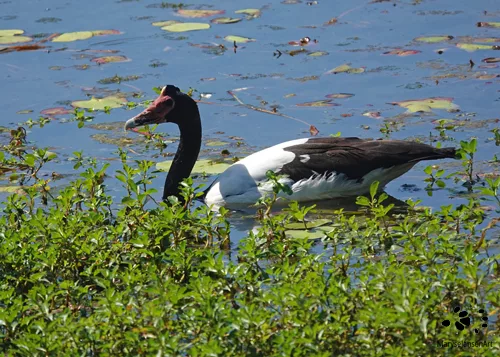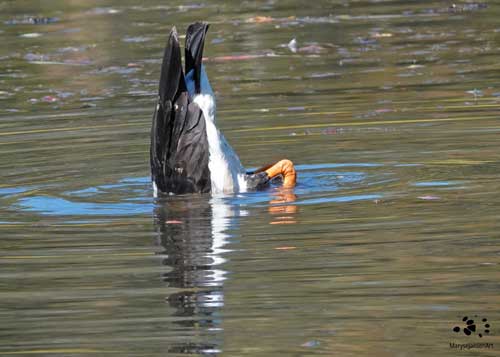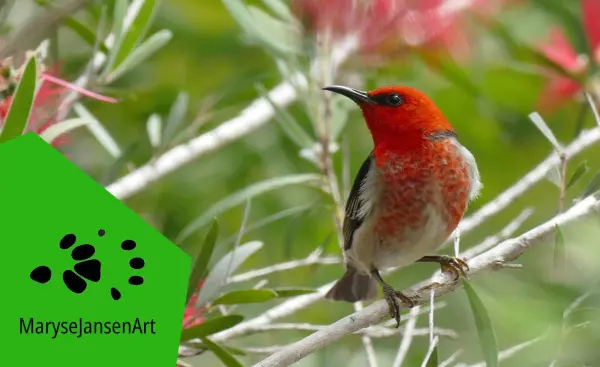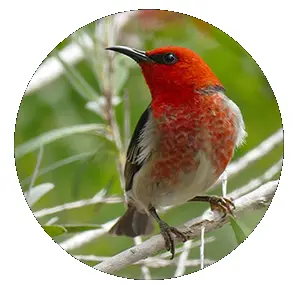Bird Photography with marysejansenart
Indicator species of healthy wetlands

Table of Contents
Black and white goose
Wow! Through the trees on the side of the track I spot a lagoon with hundreds of birds! I have to see this up close! I turn my car around and take the side track, which leads to the lagoon. The surface of the water is covered in lily pads and birds, most of which are Magpie Geese. The Magpie Geese are a noisy bunch: their call is a loud honking and in these large numbers they apparently have a lot to honk about! It is always an amazing experience to see such a large flock of birds and this is generally something that will only happen in more remote areas where there is a lot of natural space.
The Magpie Geese are not related to that other bird we know as the Magpie, but they have their black and white plumage in common. The Geese have a black head and neck. The underparts are white and contrast heavily with the black edges on their wings. On the top of their head they have a knob, which becomes larger as the birds mature. The bill is pinkish red and their legs and feet are orange. All of their appearance stands out against the backdrop of green water vegetation to create colourful images.
Unique species
Magpie Geese are common in the tropical areas of northern and north-eastern Australia and it is there where they can be seen in flocks well into their thousands! In more south-eastern areas they can also be spotted, but there they are much more uncommon and seen as vagrants. Imagine my excitement when I spot a flock of at least 20 in a local suburban lake!! I take much more notice of the details this time around. It comes to my attention that the Magpie Geese have very large, claw-like feet. Not fully webbed, like the feet of other waterfowl (ducks, geese and swans). How interesting! Check out the claw in this image:

In fact, Magpie Geese are so much different from true geese, that they belong to a different taxonomic family (the Anseranatidae). On top of that, the Magpie Goose is the only living species on earth in that family. They are sometimes viewed as a living fossil! Another distinct difference with true geese is that Magpie Geese molt gradually and therefore do not have to deal with a flightless period. (Black Swans do have a flightless molting period).
Magpie Geese are Picky eaters
Magpie Geese are primarily herbivorous and feed on aquatic plants. But they are quite picky about which plants they eat and have specialised in feeding on wild rice, spike rush, water chestnut, grass blades and seeds. Goslings are known to also take small animals like insects, snails and crustaceans. Adults only do so occasionally, perhaps accidentally. They can feed above as well as under the water surface and use their bill to tear off vegetation or scoop and turn over the mud in search of food. I see the birds here on the lake frequently tipping themselves upside down in the water to feed.

Breeding Habits
Magpie Geese mate for life, however it happens often that a male has two females! It is likely that three active parents have a better chance of protecting their offspring from predation. Groups of four parents have also been observed but are less common – they may consist of one male and three females or of two males and two females.
The nests are large platforms, floating in shallow water. They are build from plant materials such as sedges and grasses. There is enough room for the two females to lay their eggs on it. In total the clutch can be as large as 16 eggs. These geese breed in colonies. Males as well as females are involved in incubating the eggs, a process which takes around a month.
After the goslings are born, is doesn’t take long before they are able to walk (just like the Brolga chicks!). Parents feed the goslings bill-to-bill which is unusual behaviour in waterfowl. (I actually have seen Dusky Moorhens doing that too!) They have another ingenious feeding method where they step on tall grasses to bend them so that the little ones have access to the seeds. The young birds are able to fly around three months later, but stay with their parents until the next breeding season.
Aussie Bird Count
This week is the annual Aussie Bird Count! A fun way to support BirdLife Australia in developing an understanding of local birds. You can count in your own backyard, in a local park, or wherever you want. Today I went to the spot where I recently saw the Magpie Geese to do my count, hoping I would see some again and then my results would fit in nicely with today’s blog. See my results below to find out if I did see any!
The Aussie Bird Count something I do every year, check out my earlier stories about the bird count here and here. Will you join in this week? To register, click here! Let me know in the comments what you’ve spotted, I’d love to hear about your experiences!

Enjoy the footage of the Magpie Geese in the suburban lake in this Bonus video in the ‘Come for a Walk’ Series:
If you are interested in purchasing a print of ‘Magpie Goose’ or would like to see what the image looks like on the various merchandise products, please head to my shop.


